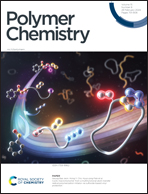Water-soluble bis-chalcone-based photoinitiators with long-wavelength absorption for radical polymerization and 3D printing†
Abstract
Two water-soluble bis-chalcone-based photoinitiators 4,4′-((((1E,1′E)-(2-oxocyclopentane-1,3-diylidene)bis(methaneylylidene))bis(thiophene-5,2-diyl))bis(9H-carbazole-3,9-diyl))bis(butane-1-sulfonic acid) (KSES) and 4,4′-((((1E,1′E)-(2-oxocyclohexane-1,3-diylidene)bis(methaneylylidene))bis(thiophene-5,2-diyl))bis(9H-carbazole-3,9-diyl))bis(butane-1-sulfonic acid) (KSTS) were successfully synthesized. The maximum absorption wavelengths (λmax) of KSES and KSTS in water were 514 and 469 nm, respectively. KSES and KSTS could be combined with diphenyliodonium hexafluorophosphate (Iod) and triethanolamine (TEOA) to form a three-component photoinitiation system, which could quickly trigger the curing of acrylate coatings under visible light with a final C![[double bond, length as m-dash]](https://www.rsc.org/images/entities/char_e001.gif) C bond conversion of more than 98%. The high free radical polymerization efficiency also made the bis-chalcone/Iod/TEOA system suitable for 3D printing, successfully printing clear and photobleached 3D objects. In addition, we carried out photosteady-state degradation, fluorescence quenching and ESR-ST experiments to further study the photopolymerization mechanism. Besides, KSES and KSTS also exhibited good biocompatibility, photobleaching performance and extremely low mobility. Considering the above excellent performance, the two water-soluble bis-chalcone-based photoinitiators reported in this study are very good choices for visible light polymerization in water-soluble systems.
C bond conversion of more than 98%. The high free radical polymerization efficiency also made the bis-chalcone/Iod/TEOA system suitable for 3D printing, successfully printing clear and photobleached 3D objects. In addition, we carried out photosteady-state degradation, fluorescence quenching and ESR-ST experiments to further study the photopolymerization mechanism. Besides, KSES and KSTS also exhibited good biocompatibility, photobleaching performance and extremely low mobility. Considering the above excellent performance, the two water-soluble bis-chalcone-based photoinitiators reported in this study are very good choices for visible light polymerization in water-soluble systems.



 Please wait while we load your content...
Please wait while we load your content...